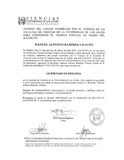| dc.rights.license | http://creativecommons.org/licenses/by-nc-sa/3.0/ve/ | |
| dc.contributor.advisor | Soriano, Pascual J. | |
| dc.contributor.author | Ramírez Chacón, Manuel Alfonso | |
| dc.date.accessioned | 2017-01-31T15:45:52Z | |
| dc.date.available | 2017-01-31T15:45:52Z | |
| dc.date.issued | 2016-03-31 | |
| dc.identifier.uri | http://www.saber.ula.ve/handle/123456789/42940 | |
| dc.description | Cotutora: Pelayo, Roxibell del C. roxibell@ula.ve | es_VE |
| dc.description.abstract | En un relicto de bosque al Sureste del Lago de Maracaibo coexisten Heliconia latispatha Benth, H.
mariae Hook F y H. bihai L, cuyas flores exhiben características ornitofílicas. Para estudiar la
ecología de su polinización evaluamos el patrón de antesis y biología reproductiva,
caracterizamos el patrón de producción de néctar y determinamos el ensamble de sus visitantes
florales, a los que determinamos su patrón de forrajeo. Monitoreamos sus flores durante la
antesis; aislamos flores en preantesis y evaluamos: autogamia; xenogamia; polinización natural
(Control 1) y polinización espontánea (Control 2); posteriormente evaluamos la producción de
frutos y semillas. Listamos los visitantes florales sobre parches de cada especie. La antesis dura
un día. En todos los tratamientos observamos producción de frutos. Heliconia bihai arrojó el
mayor número de visitantes (5 colibríes y un paseriforme ladrón), seguida por H. latispatha (4
colibríes) y H. mariae (2 colibríes). La mayoría de los colibríes exhibió un comportamiento rutero.
Heliconia bihai produce los mayores valores de volumen y concentración de néctar, seguida por
H. latipatha y H. mariae. Estos resultados parecen señalar a H. latispatha y H. bihai como
generalistas y H. mariae especialista. Finalmente, establecimos que la autocompatiblidad en estas
heliconias no es absoluta. | es_VE |
| dc.language.iso | es | es_VE |
| dc.rights | info:eu-repo/semantics/openAccess | |
| dc.subject | Polinización, | es_VE |
| dc.subject | Antesis | es_VE |
| dc.subject | Néctar | es_VE |
| dc.subject | Visitantes | es_VE |
| dc.subject | Autocompatibilidad | es_VE |
| dc.title | Ecología de la Polinización de tres especies de Heliconia (Heliconiaceae) en la Zona Sur del Lago de Maracaibo. | es_VE |
| dc.type | info:eu-repo/semantics/bachelorThesis | |
| dc.description.abstract1 | In a forest relict southeast of Maracaibo Lake coexist Heliconia latispatha Benth, H. mariae Hook F
y H. bihai L., whose flowers exhibit ornitophilic features. To study their pollination ecology we
evaluated pattern of anthesis and reproductive biology, characterized pattern of nectar production
and determined the assemblage of their floral visitors, for which we also determined pattern of
foraging. Flowers were monitored during anthesis; we isolated flowers in preanthesis and
evaluated autogamy, xenogamy, natural pollination (Control 1) and spontaneous pollination
(Control 2), after which we evaluated production of fruits and seeds. We listed floral visitors on
patches of each species. Anthesis lasts one day. In all treatments we observed fruit production. H.
bihai showed the largest number of visitors (5 hummingbirds and a robber passerine), followed by
H. latispatha (4 hummingbirds) and H. mariae (2 hummingbirds). Most hummingbirds exhibited a
foraging behavior. H. bihai produced the highest values of nectar’s volume and concentration,
followed by H. latipatha and H. mariae. These results seem to point to H. latispatha and H. bihai as
generalists, and H. mariae as specialist. Finally, we established that autocompatibility in these
heliconias is not absolute. | es_VE |
| dc.description.email | pascual@ula.ve | es_VE |
| dc.description.grado | Licenciado en Biología | |
| dc.publisher.pais | Venezuela | es_VE |
| dc.subject.departamento | Departamento de Biología | es_VE |
| dc.subject.facultad | Facultad de Ciencias | es_VE |
| dc.subject.institucion | Universidad de Los Andes | es_VE |
| dc.subject.keywords | Pollination | es_VE |
| dc.subject.keywords | Anthesis | es_VE |
| dc.subject.keywords | Nectar | es_VE |
| dc.subject.keywords | Visitors | es_VE |
| dc.subject.keywords | Autocompatibility | es_VE |
| dc.subject.tipo | Tesis | es_VE |
| dc.subject.unidadinv | Instituto de Ciencias Ambientales y Ecológicas (ICAE) | es_VE |
| dc.type.media | Texto | es_VE |


